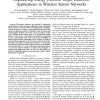Free Online Productivity Tools
i2Speak
i2Symbol
i2OCR
iTex2Img
iWeb2Print
iWeb2Shot
i2Type
iPdf2Split
iPdf2Merge
i2Bopomofo
i2Arabic
i2Style
i2Image
i2PDF
iLatex2Rtf
Sci2ools
PERCOM
2010
ACM
2010
ACM
Engineering energy-efficient target detection applications in Wireless Sensor Networks
This paper addresses the problem of engineering energy-efficient target detection applications using unattended Wireless Sensor Networks (WSNs) for long-lasting surveillance of areas of interest. As battery energy depletion is an issue in this context, an approach consists of switching on and off sensing and communication modules of wireless sensors according to duty cycles. Making these modules work in an intermittent fashion impacts (i) the latency of notification transmission (depending on the communication duty cycle) and (ii) the probability of missed target detection (depending on the number of deployed nodes and the sensing duty cycle). In order to optimize the system parameters according to performance objectives, we first derive an analytical engineering toolkit which evaluates the probability of missed detection (Pmd), the notification transmission latency (D), and the network lifetime (L) under the assumption of random node deployment. Then, we show how this toolbox can be u...
| Added | 14 Oct 2010 |
| Updated | 14 Oct 2010 |
| Type | Conference |
| Year | 2010 |
| Where | PERCOM |
| Authors | Paolo Medagliani, Jeremie Leguay, Vincent Gay, Mario Lopez-Ramos, Gian Luigi Ferrari |
Comments (0)

